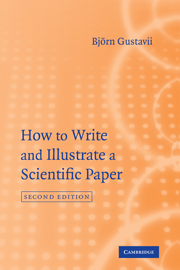Book contents
- Frontmatter
- Contents
- Preface
- Acknowledgments
- 1 Basic rules of writing
- 2 Comments on scientific language
- 3 Drafting the manuscript
- 4 Choosing a journal
- 5 Preparing a graph
- 6 Drawings
- 7 Figure legends
- 8 How to design tables
- 9 Title
- 10 Authors
- 11 Abstract
- 12 Introduction
- 13 Methods
- 14 Results
- 15 Discussion
- 16 Acknowledgments
- 17 References
- 18 Ph.D. and other doctoral theses
- 19 Letters and case reports
- 20 Numbers
- 21 Abbreviations
- 22 How to present statistical results
- 23 Typing
- 24 Dealing with editors and referees
- 25 Correcting proofs
- 26 Authors‘ responsibilities
- Literature needed on your desk
- Further reading
- Literature cited
- Index
13 - Methods
Published online by Cambridge University Press: 05 June 2012
- Frontmatter
- Contents
- Preface
- Acknowledgments
- 1 Basic rules of writing
- 2 Comments on scientific language
- 3 Drafting the manuscript
- 4 Choosing a journal
- 5 Preparing a graph
- 6 Drawings
- 7 Figure legends
- 8 How to design tables
- 9 Title
- 10 Authors
- 11 Abstract
- 12 Introduction
- 13 Methods
- 14 Results
- 15 Discussion
- 16 Acknowledgments
- 17 References
- 18 Ph.D. and other doctoral theses
- 19 Letters and case reports
- 20 Numbers
- 21 Abbreviations
- 22 How to present statistical results
- 23 Typing
- 24 Dealing with editors and referees
- 25 Correcting proofs
- 26 Authors‘ responsibilities
- Literature needed on your desk
- Further reading
- Literature cited
- Index
Summary
Methods are usually best described in the order in which they were used. So, in the following sentence, taken from a manuscript in preparation, it would be helpful if you reversed the order of presentation, as from:
Cell growth was stopped with colchicine after incubation for 65–70 hours at 37°C.
to:
After the incubation of cells for 65–70 hours at 37°C, their growth was stopped with colchicines.
Unless a previously published method is generally known, the reader will appreciate being told its essential features. Thus, a reference figure may well be considered inadequate, as in this example from a manuscript in preparation:
Kidney volume was measured as previously described.
Little need be added to give the reader the broad outline of the method (revised text in boldfaced italics):
The kidney volume was measured with an ultrasound apparatus containing a built-in volume program.
A new procedure, however, should be described in sufficient detail to allow a trained scientist to repeat the investigation. For the novice writer it can be hard to find a middle course between too much and too little information; often the novice errs on the side of too much. An experienced colleague can help to remove excess detail.
The subjects
I once saw a note taped to a door asking for volunteers – completely healthy, nonsmoking women aged 55 to 60 – to participate in a study of the effect of estrogen on blood circulation in the legs. The door led from a huge bicycle garage (reserved for workers at the hospital) into the elevator hall.
- Type
- Chapter
- Information
- How to Write and Illustrate a Scientific Paper , pp. 63 - 67Publisher: Cambridge University PressPrint publication year: 2008



